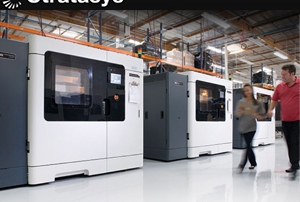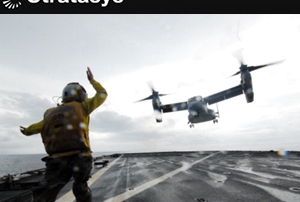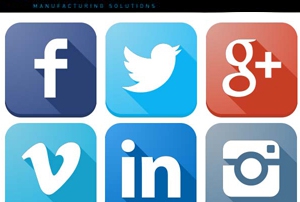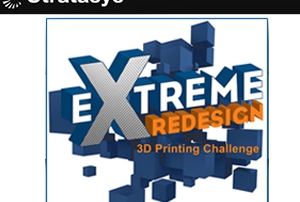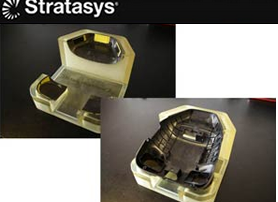Stratasys Direct Manufacturing’s Fused Deposition Modeling (FDM) Services
Fused Deposition Modeling (FDM) is one of the only professional 3D printing technologies that uses production-grade thermoplastics. Design and manufacturing engineers, design and engineering services as well as aerospace, automotive, medical and energy companies are using FDM. “With the broadest selection of engineering thermoplastic materials from ABS to ULTEM small, Stratasys Direct Manufacturing has helped customers apply the FDM process to a wide variety of product development and manufacturing needs.” — Chuck Alexander, Director of Product Management, Stratasys Direct Manufacturing Stratasys Direct Manufacturing requires an STL file for FDM services. The STL file format is a very common format that any CAD system can convert to making Direct Manufacturing accessible to just about everyone. Rather than selling machines, Stratasys Direct Manufacturing sells 3D printing services. As a part of the Stratasys organization, Stratasys Direct Manufacturing has the widest variety of available FDM services. You can find much more information directly on the Stratasys Direct Manufacturing site here.
Navy Uses 3D Printing Technology in Weapons Systems
The Navy has been using 3D printed parts on the Osprey tilt-rotor craft and plans to expand the uses of the technology. (Photo : Allen Onstott / U.S. Navy via Getty Images) The U.S. Navy explored fleet applications of additive manufacturing, or 3D printing, into naval weapons systems at the 2015 Naval Additive Manufacturing Technical Interchange (NAMTI) meeting at the Carderock Division of the Naval Surface Warfare Center. Hundreds of engineers, scientists, acquisition professionals and 3D printing experts, discussed naval applications of additive manufacturing for bio-printing, self-sustaining ships and energetics, such as military weapons. The U.S. Navy reports five ways it has used 3D printing technology successfully: Save money and time. Norfolk Naval Shipyard's Rapid Prototype Lab is saving the Navy thousands of dollars by printing cheaper plastic polymer models of aircraft carrier ship alterations in hours, rather than days or weeks for traditional wood or metal mockups. Innovative. The Navy's Fleet Readiness Center Southeast used the technology to develop an improved hydraulic intake manifold for the V-22 Osprey. The new manifold is 70 percent lighter, improves fluid flow and has less leak points. Customizable. By customizing 3D printed parts, the Walter Reed National Military Medical Center produces medical items, including [...]
Let’s Connect
Cimquest is very active in social media and we work hard to produce lots of useful content for our community. Whether you’re using Mastercam, Statasys, or SOLIDWORKS . . . or just interested in the CAD/CAM world, you are sure to find something helpful. In addition to posting the content here on our blog we also engage with the community through various other social outlets including Facebook, Twitter, YouTube, LinkedIn, Google+, and Instagram. From important product update information to handy tips and tricks no matter what platform you’re on, we're there offering you something. Wherever you like to spend your time you can connect with us! And we do mean “connect.” Not only do we push content out for you to read and watch, but we are also there to listen. We encourage you to interact with us. Have a question, or just want to share your latest cool new project? We would love to hear from you! Please use the links below to be taken directly to our specific channels.
3D Printing Student Design Contest Winners Announced
Stratasys has announced the winners of their 11th annual Extreme Redesign Contest. The 2015 Extreme Redesign 3D Printing Challenge was open to middle school, high school, and college students around the world in engineering, design, and art or architecture. This year’s winners include: Art & Architecture Category 1st Place: “Helico” Helix-shaped Sharpener by Haya Alnibari, Ti Fu, Toronto, ON, Canada Ryerson University, Instructor: Vincent Hui Engineering: Secondary Education 1st Place: HUNCH 2015 Zero Gravity Scale by Thomas Vagnini, Franklin, MA USA Tri-County Regional Vocational Technical High School, Instructor: Kristen Engineering: Post Secondary 1st Place: Cooling with Heat by Melanie Gralow and Lena Heeman, Bremen, Germany University of Bremen Each year, students are invited to redesign an existing product, or come up with a design for a new product that improves how a task is currently done. Designs are judged on four different aspects: sound mechanical design and part integrity; design creativity; product usefulness; and a compelling written and/or video description. Designs submitted for the Art or Architecture category are also judged on aesthetics. First-place winners in all categories received a $2,500 scholarship, and the first-place student's instructor received a demo 3D printer to use in the classroom for a limited time. For the [...]
Lamborghini Accelerates and Perfects Automotive Engineering with Stratasys 3D Printed Prototypes and Track-Ready Parts
(This article is a repost from the Statasys corporate blog.) Lamborghini’s 50 year heritage has seen the brand become synonymous with extreme and uncompromising automotive design. With a 50 year heritage that has seen its brand become synonymous with extreme and uncompromising automotive design, Lamborghini relies upon the most cutting edge technologies to uphold its reputation for automotive excellence. Meeting this objective is aided by the company’s continued use of Stratasys FDM-based 3D printing technology, which Lamborghini employs throughout the entire lifecycle of its parts, from rapid prototyping applications to direct digital manufacturing of end-use parts. As you’re about to see, Stratasys additive manufacturing brings several major advantages to automotive engineering including greater design freedom since manufacturing is performed in a digital environment, the accelerated development of functional prototype parts, the ability to produce durable, heat-resistant parts using thermoplastics, and overall faster responsiveness to market demands. Tough Parts with Complex Geometries Delivered in Record Time According to Fabio Serrazanetti of Lamborghini’s car body technical department, the requirement to produce high-strength end-use parts, tough enough to endure the rigors of high-speed racing, as well as the need to create complex geometries in a very tight timeframe, led the company’s engineers to explore [...]
How 3D Printing Customized Jigs and Fixtures Saves Rutland $60,000 Per Year
5 Jan. 2015 by Stratasys Staff Rutland Plastics is a custom injection molding company located in Rutland, United Kingdom that produces products for a wide range of companies and industries. Because each project is unique, Rutland must create complementary jigs and fixtures to position and hold the project’s components during manufacturing operations like assembly, gluing, drilling, and measuring. Now thanks to Stratasys 3D printing, creating a steady stream of assembly tools 100% customized for each job, in practically no time, is the new reality at Rutland. Method Annual Production Time Cost CNC 300 days $150,000 PolyJet 100 days $90,000 Savings 66% 40% Why Conventional Wasn’t Cutting It The jigs and fixtures at Rutland are crucial because they streamline the production process, help employees become more efficient, and ensure consistency of the final product. However, as the company grew, creating the jigs and fixtures using conventional methods became a costly burden. Rutland traditionally made approximately 100 new jigs and fixtures annually from aluminum on its CNC milling machines. This process cost $1,500 per piece or $150,000 per year. But the true cost to the company was far greater. Each new jig and fixture also took 3 days to create. This meant that the [...]


